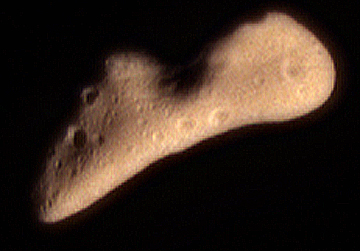
September 24, 2000 Laurel, Maryland - Scientists at the Near Earth Asteroid Rendezvous (NEAR) mission in Johns Hopkins University's Applied Physics Laboratory are recommending to NASA that the NEAR satellite now orbiting asteroid 433 Eros dive down to within five kilometers (3 miles) of the asteroid surface in late October. The South Pole of Eros, which has been pointed away from the sun until now, will be lighted and is the likely target area. There are also many features on Eros that scientists would like to see more closely, including ridges, troughs, large boulders and craters that are square. Detailed survey data has been published inScience and one of the puzzles for geologists and astronomers are many loose boulders laying around on the surface. Eros is a relatively small mass, so it was logical to expect a smoother surface from which debris would have been knocked off into space over its 4.5 billion year evolution from the beginning of the solar system.
Click here to subscribe and get instant access to read this report.
Click here to check your existing subscription status.
Existing members, login below:
© 1998 - 2024 by Linda Moulton Howe.
All Rights Reserved.

